The QSP Swordfish is a budget-friendly pocketknife that is not long, thin or lean like its namesake the Swordfish. QSP is basically an acronym for Quality, Service, and Price and signifies the company’s products’ USP (Unique Selling Point). QSP releases new models at a healthy pace.
Another interesting thing about QSP is that it names all its models of cutlery after animals. Swordfish is one example. Gannet is another, which is a large white seabird that hunts for fish by plunge diving into the surface of the water to catch fish. Same goes for QSP Penguin I wrote earlier.
Similarly, Gannets do not divebomb any Swordfish that weighs 50-200 pounds and is around 10 feet long. They can also swim at the rate of 50 miles an hour with that long boney nose they use to claw into their prey.
QSP Swordfish Button Lock Folding Knife Review
The QSP Swordfish is around 8.125” long in overall length, with a 3.625” blade length and 4.50” handle length. Its blade stock thickness is 0.118”, and the blade is as wide as 0.13” along the spine. The blade’s cutting edge is 3.375” and features a modified Wharncliffe blade shape style. The 14C28N blade comes with a stonewash finish and a high flat grind.
The knife sports a G10 handle with a button lock and ceramic ball bearings flipper mechanism. It weighs only 4.13 ounces.

Key Specifications of QSP Swordfish
First Impression of QSP Swordfish Button Lock Knife
The QSP Swordfish came in a simple standard branded packaging with QSP logo on it. It came with a barcode sticker mentioning the model of the knife. The card inside the box came with a drawing of the product mentioning all its features. So if you do not already know about the knife’s specs or a new knife user, you can check out the user guide for details.
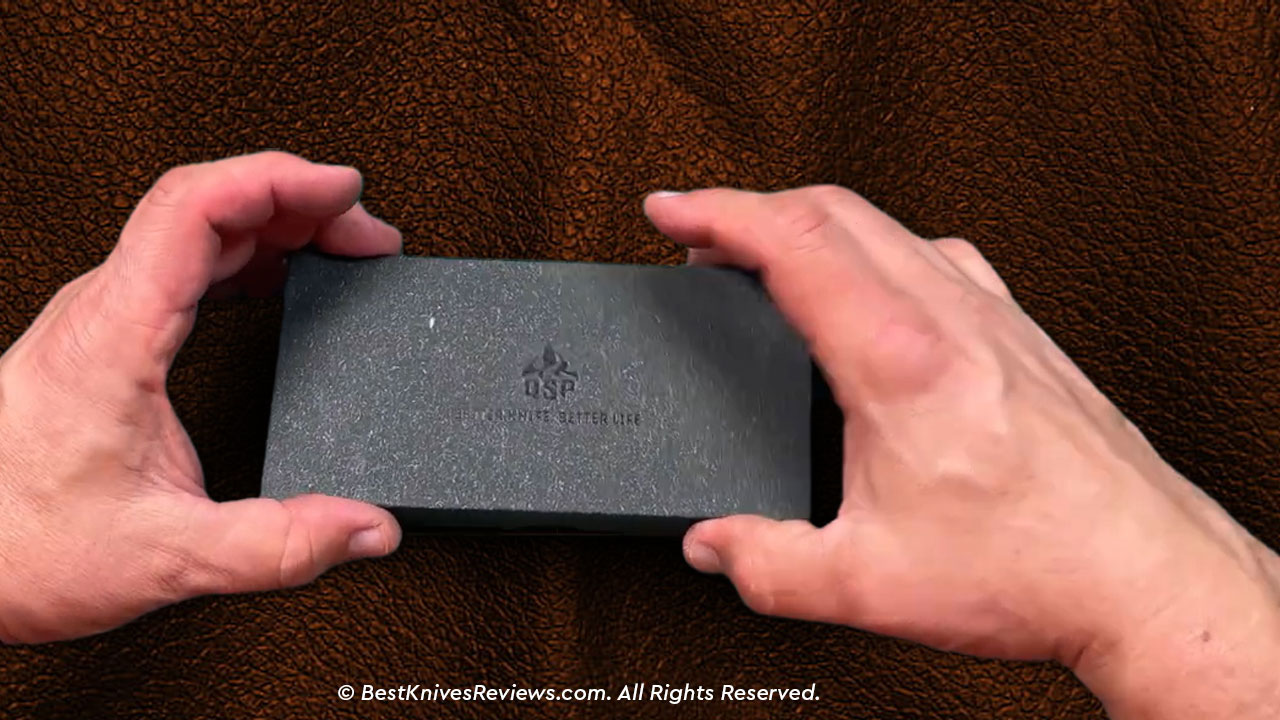
The knife that we received had a red handle. It was actually dual laminated with black G10 atop the red G10. The button lock worked exceptionally smoothly. The detent was just fine, and the blade was perfectly centered within the liners. The overall finishing of the knife right out of the box was very well done and clean.
The black stonewash finish on the blade was marvelous, without any scratches or oils. The thumb studs and the flipper was very well-placed, not getting in the way of anything really.
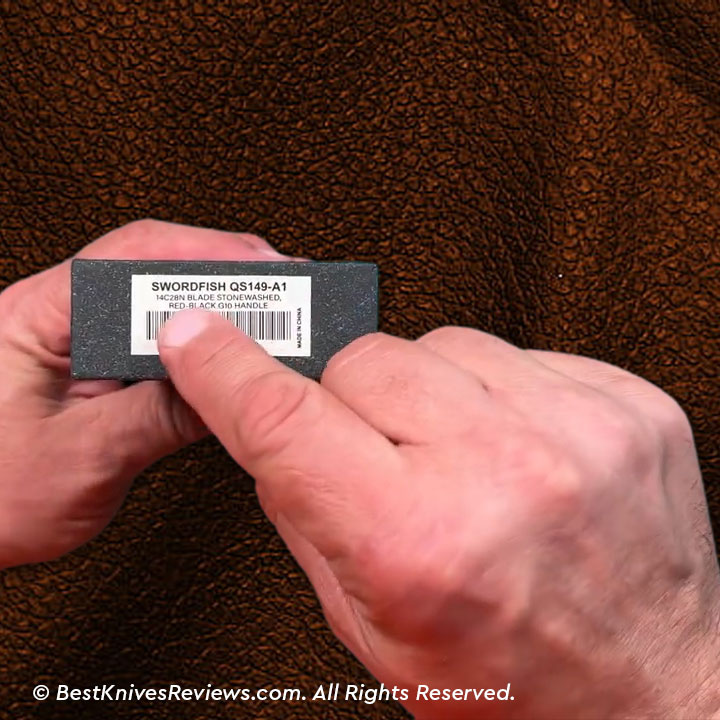
The reversible wire clip was of just the right size, yet deep pocket carry configured for both left and right hand. The knife is also very well contoured around the edges, so there are no hot spots or rough edges.

The thumb stud opens the knife up in a single light flick. The button also works pretty well. The flipper action is also just as smooth. However, you cannot open the knife using a reverse flick. This is not a feature of the knife but we tried it regardless. But you can disengage the blade using both your hands if that is what you want.
When we opened up the blade, it felt a little loose. It had to be tightened up. But that was not a big deal, since the screws were pretty simple to disassemble the knife. The finger choil was also pretty comfortable to slide up your thumb and choke up the knife for precise cutting. However, the sharpening choil is not a full-fledged finger choil and is not large enough. But you can still choke up the knife regardless.
It had a very thin and sharp grind, and the blade was also razor-sharp right out of the box. The modified Wharncliffe also looked a lot like a reverse tanto. There is a lot of surface area for the edge, so it will be useful as a utility tool.
The knife is pretty robust and very well chamfered. It was comfortable to hold with a good built.
Blade of QSP Swordfish Button Lock Knife
The blade of QSP Swordfish with its modified Wharncliffe shape has its sharpened edge entirely straight, with the blade spine curving down to meet the tip below the center point of the handle. It is modified because the spine is not a constant curve down towards the tip.
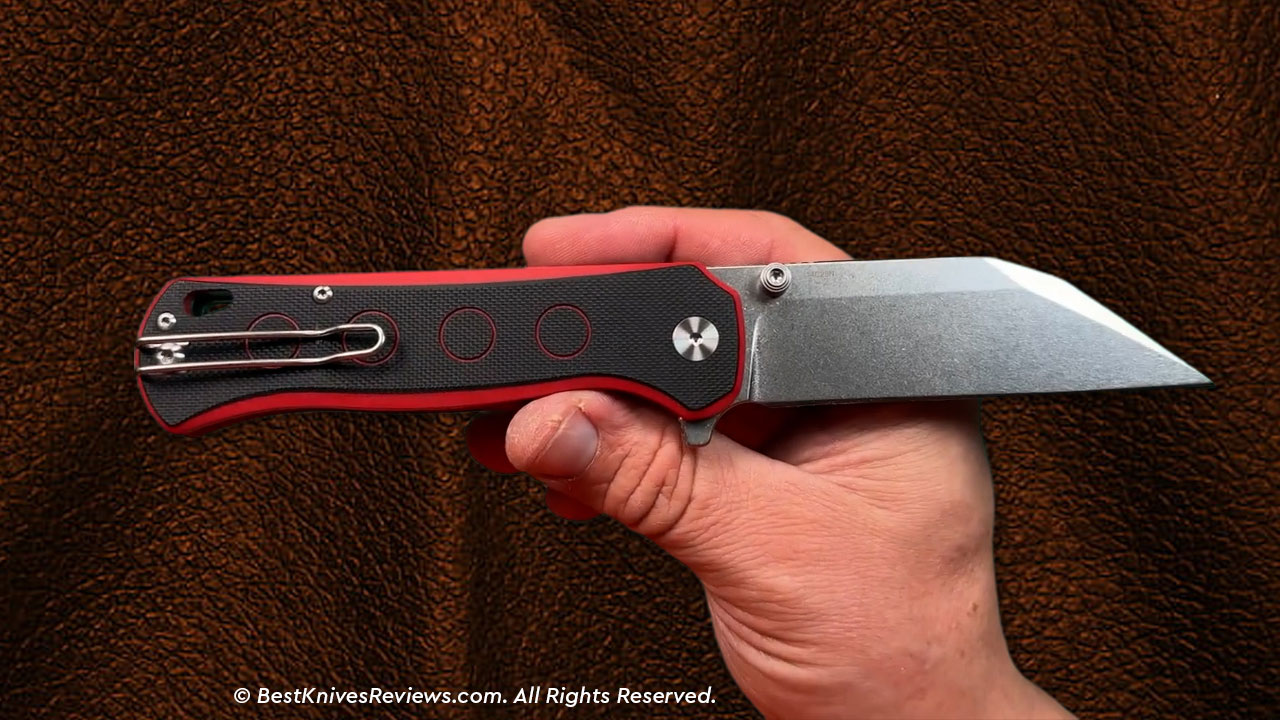
There are very few modern Wharncliffes that meet the strict definition of that blade type. The blade spine comes out parallel to the edge about two-thirds of the length of the entire blade. It then pivots down to the sharp angle with a compound false swedge, thinning the blade geometry as it reaches the tip. It makes the edge sharper and provides it better piercing abilities while retaining the blade strength of the cleaver shaped blade.
The flat grind narrows at the flat section of the blade towards the spine for a better blade slicing geometry – hence the high flat grind. It has vertical plunge line at the rear that terminates midway to the sharpening choil.

This choil is not large or deep enough to be a forward finger choil. The blade shape is well-suited for opening packages, punching and piercing through thick cardboard boxes and slicing open envelopes. The position of the tip down relative to the center of the handle provides it the ability to make angled cuts more natural like utility blades.

The 14C28N stainless steel blade is from a Swedish manufacturer Allemia, formerly known as Sandvick Materials Technology. It was manufactured as an upgrade to the 13C26. If you add more corrosion resistance to 13C26, you get the 14C28N with 14% chromium and 0.62% carbon. It is a high-quality entry level stainless steel, excellent for cutlery.
Its hardness comes out to be 59-61 HRC, which is quite good for a cutlery or EDC knife. It is also very tough and less prone to chipping. However, you will need to sharpen it more often for good results. But for a budget steel, it strikes a great balance between edge retention, toughness and corrosion resistance, which makes it a high performer.
The black stonewash finish protects the blade from tarnishing, scratches and fingerprints. It is also available in regular stonewash at the same price.
Handle of QSP Swordfish Button Lock Knife
You have the option to choose between black and red G10 scales or green or brown canvas Micarta scales on the Swordfish. We got the one with Red and Black G10 scales. The G10 scales are better than the Micarta, since they are laminated with more layers and very well textured and contoured around the edges. It is wider towards the center and steeper towards the edges, which gives a more secure grip.

The G10 scales also provide a very ergonomically friendly grip – smooth yet grippy and comfortable. The G10 is perfect for budget-friendly knives like the QSP Swordfish and are very well laminated.
The scales sit atop nested skeletonized stainless steel liners with a series of drilled holes to reduce weight. These are black coated to match the color of the blade. The Swordfish has a polymer backspacer and is partially flow-through with the body screws threading into metal inserts in the backspacer on both sides to tie the knife together. The scales are overall well-constructed and finished with a bit of complex contouring. The blade is perfectly centered within the scale liners when closed.

The backspacer also has an oblong shaped lanyard hole passing through it. The pivot has a Chicago-style screw with the female side anchored towards the liners via D-shaped barrel to prevent it from spinning. The decorative pivot features the QSP logo with the flush-fitting back pivot Torx T8 screw fitting on the opposite side. The body screws are T6 and clip screws are T8. The simple construction makes the knife easy to maintain by making it easy to disassemble and reassemble

The wire pocket clip is a deep pocket carry clip with two parallel slots and a single screw. It is configured for ambidextrous tip-up carry with both left and right hand carry.
Deployment & Lockup of QSP Swordfish
The QSP Swordfish comes with two ways of deployment: the finger flipper and the ambidextrous thumb studs. The locking mechanism is that of a button lock. The knife uses a set of caged ceramic pivot ball bearings is ultra-low friction and delivers a smooth opening and closing action. The push button requires the least amount of pressure to disengage the blade. The thumb studs also work just as smoothly.
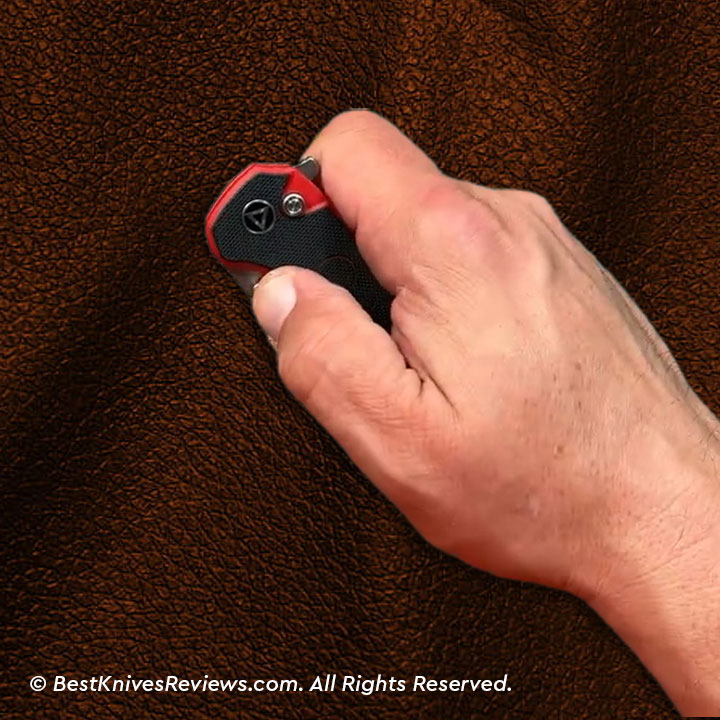

The detent on this knife is great, with the exception of the button lock that does not have a dedicated detent ball for tension. It relies on the spring tension in the plunger to create resistance. It works better with the thumb studs than the flipper though because you can apply more force and leverage with your thumb than with your index finger. The lock opens with a single flick action. But both the methods work well.

You can use the button lock to hold the lock down and flip the blade open with your wrist. Although, the lock has to be released fast enough, but the closing action is smoother. The blade drops shut under its own weight when you press the button lock.


It easily removes the friction between blade tang and plunger. The button lock works well with the external stop pin anchored to the steel liners for a durable and solid lockup.
My Experience with QSP Swordfish Knife
For those who are used to standard 7” pocketknives that weigh less than 4 ounces, the Swordfish may feel bigger and heavier. However, it is not uncomfortable to carry. The wire clip makes it easy and lightweight to carry around.
The G10 scales are low-friction, so they do not create any hot spots in your pocket when brushed against other objects. It slides entirely into your pocket but does not get stuck in there, thanks to the spring wire pocket clip. But the spine of the blade protrudes out quite a bit. The good thing is that it will not slide open while it is in your pocket. The lockup is pretty solid and the knife will not disengage on its own. But it does take space in your pocket.
The contouring of the handle has really paid off, since it is very comfortable to hold and will not slip from your hands. The jimping along the spine above the thumb stud assists in comfortable use. The pocket clip also does not get in the way while using the knife. You can also use the knife with wet hands. We also found during the field test that the flipper tab doubles as an extended finger guard, which provides great ergonomics on this knife.

The G10 does not accumulate dirt or oil while using, unlike the Micarta scales on the other variant. That means it will not lose its attractiveness and would not get tarnished over weeks of usage. But the downside of the G10 variant is that it is heavier, aka 4.41 oz. as opposed to Micarta’s 4.13 oz.
The blade shape works well in pinching through stuff as expected. It has excellent edge holding and edge retention. You can use the tip to cut open heavy cardboard boxes with more finesse than with a drop point blade. So the shape of the blade may be unique, but it provides more functional utility.
The knife is also easy to maintain as it comes apart with just two screws. And it is easy to sharpen, but has to be done more frequently as you would with the other blade material. It also has no beard at the end of the blade, so it is pretty smooth and well-shaped.
Pros & Cons of QSP Swordfish
PRO’s
Con’s
Comparisons
QSP Swordfish vs SENCUT Watauga
SENCUT Watauga also comes with a button lock, stonewash finish Wharncliffe blade, G10 scales and is as long as 8”. It also deploys with a flipper that works well. However, it is only priced at $45. Sencut knives are of high-quality and are budget-friendly, but do not have the same fit and finish as on the QSP Swordfish. But it offers good value for money.
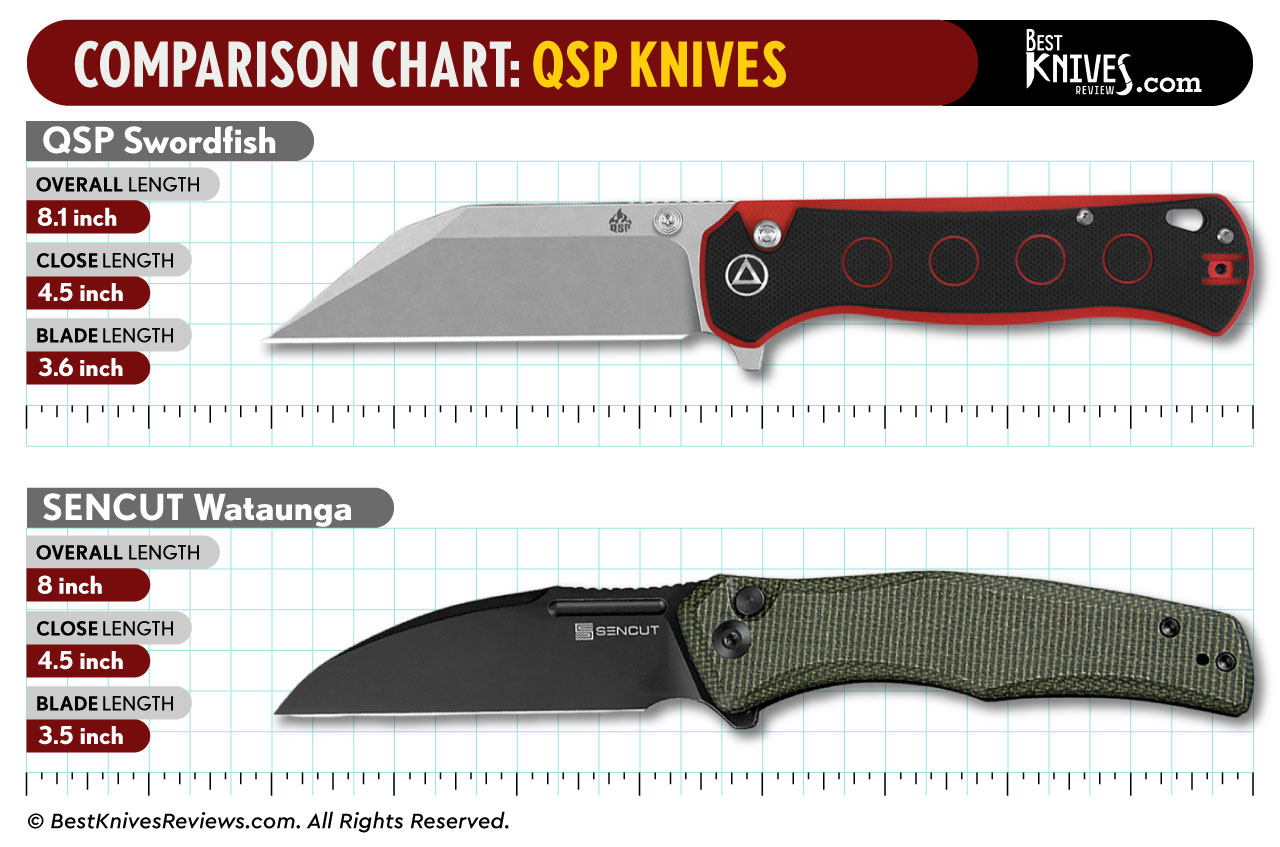
It features a D2 blade that is very sharp with excellent blade geometry. It also weighs just 3.69 oz. and comes with a deep pocket carry. So it is lightweight and easy to carry. It also has a larger finger choil and a finger choil to choke up the blade; something that is missing on the QSP, but that does not make it a bad knife.
Both the knives are good, features and performance wise.
QSP Swordfish vs Ferrum Forge Prolix
The Prolix by Ferrum Forge is quite like the QSP Swordfish with a traditional Wharncliffe blade 2.875” long with a usable forward finger choil. Its cutting edge is also exceptional at 2.375”, making it smaller and lightweight than the Swordfish, weighing only 2.74 oz.

However, it does feature ball bearing pivot deployment same as the Swordfish with a flipper and thumb hole opening mechanism. It also has flat G10 scales, but with a blade made from Nitro V stainless steel. It is very well made and of high quality built.
Conclusion: QSP Swordfish Review
We found the QSP Swordfish review to be quite good. Its blade is very well-shaped with excellent edge holding and retention, and the overall blade geometry. It also does a fine cutting job. The blade came sharp right out of the box and is an excellent utility tool.
The G10 handle is ergonomically friendly and does not accumulate dirt and oils. The wire pocket clip is configured for both right and left hand carry, and makes the knife lightweight to carry. Although, the knife itself weighs more than a standard pocketknife, more than 4 ounces. The skeletonized stainless steel liners hold the blade perfectly, and it sticks out perfectly straight when open.

The knife comes together with just two Torx screws of T6 and T8, so it is easy to disassemble and maintain. The blade is easy to sharpen but requires it more frequently.
The flipper and thumb studs both work very smoothly to deploy the knife, and the button also works just as smoothly. The detent has just the right amount of friction and allows smoother action.
